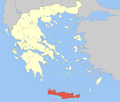Kissamos Province
History
Strabo said that ancient Cisamus was dependent on Aptera and was its naval arsenal. The Peutinger Table distinguishes two port towns in Crete called Cisamus, Modern Kissamos (at 35°29′38″N 23°39′25″E) is much further west than where Aptera is now placed (at 35°27′46″N 24°8′31″E). It was excluded already by Pashley in 1837 as being, of the two ancient maritime Cretan cities named Kisamos, the one associated with Aptera. In the past, when the port of Aptera was thought to be present-day Kissamos, some supposed Aptera to be identical with Polyrrhenia, and Kissamos to be the port of Polyrrhenia. However, Strabo and other ancient sources say that Polyrrhenia's port was at Phalasarna on the west coast.
Ecclesiastical history



Ancient Cisamus became a Christian bishopric, a suffragan of the metropolitan see of Gortyna, the capital of the Roman province of Crete. Only two of its first-millennium bishops are named in extant contemporary documents: Theopemptus (according to 18th-century Lequien), Nicetas (according to 20th-century Janin) at the Trullan Council in 692, and Leo at the Second Council of Nicaea in 787.
Orthodox bishopric
The bishopric is still a residential see of the Eastern Orthodox Church of Crete.
Latin diocese
After the Venetian conquest of Crete in 1212, Kissamos became a Latin Church diocese. The names of more than 20 residential Latin bishops from then until the end of the 16th century are known, including :
- Angelo Barbarigo (1383 – 1406.09.21)
- Prospero Santacroce (1548.03.22 – 1572?)
The Latin residential bishopric of Latin: Cisamus (Curiate Italian Cisamo) was suppressed in around 1600, and only a titular bishopric remains.
Municipality

The municipality of Kissamos was formed at the 2011 local government reform by the merger of three former municipalities, which became municipal units:
The municipality has an area of 341.018 km (131.668 sq mi) and the municipal unit has an area of 149.034 km (57.542 sq mi). The municipal unit of Kissamos includes the Gramvousa peninsula (Chernisos Gramvousas Χερσόνησος Γραμβούσας) in the northwest and the adjacent Gramvousa islets, as well as the islet of Pontikonisi, and the villages of Sfinari, Koukounaras, Polirinia, Platanos, Lousakia, Sirikari, Kallergiania and Kalathena. It forms the extreme western part of the Chania regional unit, and of Crete. It is bordered by Platanias to the East, and by Kantanos-Selino to the south.
Former province
The province of Kissamos (Greek: Επαρχία Κισσάμου) was one of the provinces of the Chania Prefecture. Its territory corresponded with that of the current municipality of Kissamos, and the municipal units of Kolymvari and Voukolies (partly). It was abolished in 2006.
Notable locals
- Manos Katrakis (1908–1984), actor
- Giorgis Koutsourelis (1914–1994), Cretan music composer
See also
References
- ^ Municipality of Kissamos, Municipal elections – October 2023, Ministry of Interior
- ^ "Αποτελέσματα Απογραφής Πληθυσμού - Κατοικιών 2021, Μόνιμος Πληθυσμός κατά οικισμό" [Results of the 2021 Population - Housing Census, Permanent population by settlement] (in Greek). Hellenic Statistical Authority. 29 March 2024.
- ^ J.A. Cramer, A Geographical and Historical Description of Ancient Greece (1828), Vol. 3, pp. 364, 379
- ^ John D. Pendlebury, The Archaeology of Crete (Biblo & Tannen 1969 ISBN 978-0-81960121-6), p. 21
- ^ Robert Pashley, Travels in Crete (J. Murray 1837), vol. 1, pp. 49, 55
- ^ Edward Falkener, A Description of Some Important Theatres and Other Remains in Crete (Trübner 1854), p. 26
- ^ Pendlebury (1969), p. 14
- ^ J.A. Cramer, A Geographical and Historical Description of Ancient Greece (1828), Vol. 3, p. 364
- ^ Raymond Janin, v. Cisamus, in Dictionnaire d'Histoire et de Géographie ecclésiastiques, vol. XII, Parigi 1953, coll. 844-845
- ^ Konrad Eubel, Hierarchia Catholica Medii Aevi, vol. 1 Archived 2019-07-09 at the Wayback Machine, pp. 185–186; vol. 2 Archived 2018-10-04 at the Wayback Machine, p. 127; vol. 3 Archived 2019-03-21 at the Wayback Machine, p. 166; vol. 5, p. 158; vol. 6, p. 166; vol. 8, pp. 205–206
- ^ "Diocese of Kisamos" Catholic-Hierarchy.org. David M. Cheney. Retrieved February 29, 2016
- ^ "Titular Episcopal See of Cisamus" GCatholic.org. Gabriel Chow. Retrieved February 29, 2016
- ^ Annuario Pontificio 2013 (Libreria Editrice Vaticana 2013 ISBN 978-88-209-9070-1), p. 870
- ^ "ΦΕΚ A 87/2010, Kallikratis reform law text" (in Greek). Government Gazette.
- ^ "Population & housing census 2001 (incl. area and average elevation)" (PDF) (in Greek). National Statistical Service of Greece. Archived from the original (PDF) on 2015-09-21.
- ^ "Detailed census results 1991" (PDF). Archived from the original (PDF) on 2016-03-03. (39 MB) (in Greek and French)
